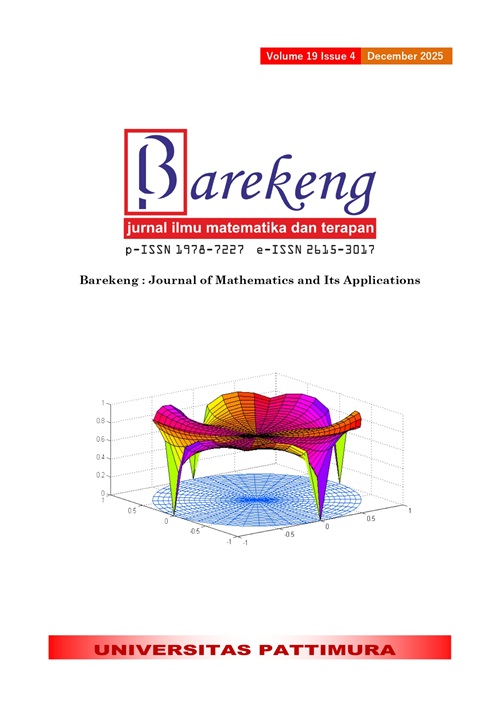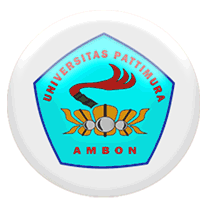DYNAMIC ANALYSIS OF THE MATHEMATICAL MODEL FOR STUNTING WITH NUTRITION AND EDUCATION INTERVENTIONS
Abstract
This study presents a mathematical model that analyzes the impact of nutrition and education interventions on stunting prevalence. Nutritional interventions are carried out on toddlers indicated to be stunted and toddlers who are healthy but susceptible to stunting. Meanwhile, education is given to the toddler's mother compartment. The model categorizes the toddler population into four compartments: susceptible, stunting-indicated, permanently stunted, and non-stunted. Similarly, the maternal population is categorized into three compartments: susceptible mothers, mothers exhibiting poor parenting practices, and educated mothers. The model's equilibrium point comprises two distinct states: a stable stunting-free equilibrium point when the basic reproduction number (R0) is less than one and a stable stunting-endemic equilibrium point when R0 is more significant than one. Sensitivity analysis reveals that the parameters that significantly influence the reduction or increase in stunting cases are the rate of nutritional intervention for children and the intensity of education for mothers. Numerical simulations demonstrate that implementing nutritional intervention activities and continuous education programs can effectively eliminate stunting cases in the population. The simulation results show a high number of stunting cases, reaching 161,566 cases in the population, due to poor education and poor nutritional interventions. In contrast, education programs and effective nutritional interventions eliminate stunting from the population. However, it takes longer.
Downloads
References
Wakil Presiden RI, 100 KABUPATEN/KOTA PRIORITAS UNTUK INTERVENSI ANAK KERDIL (STUNTING). Jakarta: Sekretariat Wakil Presiden Republik Indonesia, 2017.
Wakil Presiden RI, “CEGAH STUNTING, WAPRES MINTA KELUARGA INDONESIA PRIORITASKAN KEBUTUHAN GIZI ANAK DAN SANITASI,” Sekretariat Wakil Presiden Republik Indonesia, 2023. https://stunting.go.id/cegah-stunting-wapres-minta-keluarga-indonesia-prioritaskan-kebutuhan-gizi-anak-dan-sanitasi/ (accessed Jan. 21, 2024).
Kementerian Kesehatan RI, Wartakesma: CEGAH STUNTING ITU PENTING, 2nd ed. Jakarta, 2018.
Kementerian Kesehatan RI, “BUKU SAKU HASIL SURVEI STATUS GIZI INDONESIA (SSGI) 2022,” Kementeri. Kesehat. Republik Indones., pp. 1–150, 2022.
B. Bustami and M. Ampera, “The Identification of Modeling Causes of Stunting Children Aged 2–5 Years in Aceh Province, Indonesia (Data Analysis of Nutritional Status Monitoring 2015),” Open Access Maced. J. Med. Sci., vol. 8, no. E, pp. 657–663, 2020, doi: https://doi.org/10.3889/oamjms.2020.4659.
A. Candra, EPIDEMIOLOGI STUNTING. Universitas Diponegoro, 2020.
J. Castro-Bedriñana, D. Chirinos-Peinado, and G. De La Cruz-Calderón, “PREDICTIVE MODEL OF STUNTING IN THE CENTRAL ANDEAN REGION OF PERU BASED ON SOCIOECONOMIC AND AGRI-FOOD DETERMINANTS,” Public Heal. Pract., vol. 2, p. 100112, 2021, doi: https://doi.org/10.1016/j.puhip.2021.100112.
Kemendesa PDTT, BUKU SAKU DESA DALAM PENANGANAN STUNTING. Jakarta: Direktur Jendral PPM Desa, 2017.
E. Musheiguza, T. Mbegalo, and J. N. Mbukwa, “BAYESIAN MULTILEVEL MODELLING OF THE ASSOCIATION BETWEEN SOCIO-ECONOMIC STATUS AND STUNTING AMONG UNDER-FIVE-YEAR CHILDREN IN TANZANIA,” J. Heal. Popul. Nutr., vol. 42, no. 1, p. 135, 2023, doi: https://doi.org/10.1186/s41043-023-00474-3.
S. D. Hove-Musekwa, F. Nyabadza, C. Chiyaka, P. Das, A. Tripathi, and Z. Mukandavire, “MODELLING AND ANALYSIS OF THE EFFECTS OF MALNUTRITION IN THE SPREAD OF CHOLERA,” Math. Comput. Model., vol. 53, no. 9–10, pp. 1583–1595, 2011, doi: https://doi.org/10.1016/j.mcm.2010.11.060.
M. Manaqib, M. Azizah, S. Pratiwi, and R. A. Maulana, “ANALISIS MODEL MATEMATIKA PENYEBARAN PENYAKIT COVID-19 DENGAN LOCKDOWN DAN KARANTINA,” BAREKENG J. Ilmu Mat. Dan Terap., vol. 15, no. 3, pp. 479–492, 2021, doi: https://doi.org/10.30598/barekengvol15iss3pp479-492.
L. O. Sabran, I. D. Rianjaya, L. H. Hasibuan, and L. O. Nashar, “ANALYSIS OF COVID-19 FOMITE TRANSMISSION MODEL WITH DISINFECTANT SPRAY,” BAREKENG J. Ilmu Mat. dan Terap., vol. 16, no. 3, pp. 1021–1030, 2022, doi: https://doi.org/10.30598/barekengvol16iss3pp1021-1030.
M. Jannah, M. A. Karim, and Y. Yulida, “ANALISIS KESTABILAN MODEL SEIR UNTUK PENYEBARAN COVID-19 DENGAN PARAMETER VAKSINASI,” BAREKENG J. Ilmu Mat. dan Terap., vol. 15, no. 3, pp. 535–542, 2021, doi: https://doi.org/10.30598/barekengvol15iss3pp535-542.
M. I. Pratama and A. Lismayani, “SIMULASI PEMODELAN MATEMATIKA SEIR TERHADAP PENGARUH SANITASI PADA KASUS STUNTING DI INDONESIA,” Prox. J. Penelit. Mat. dan Pendidik. Mat., vol. 6, no. 1, pp. 224–231, 2023, doi: https://doi.org/10.30605/proximal.v6i1.2230.
A. Winarni, N. Sofiyati, and U. F. Rudatiningtyas, “ANALYSIS AND SIMULATION OF SEIR MATHEMATICAL MODEL OF STUNTING CASE IN INDONESIA,” Mathline J. Mat. dan Pendidik. Mat., vol. 9, no. 3, pp. 871–886, 2024, doi: https://doi.org/10.31943/mathline.v9i3.555.
H. W. Hethcote, “THE MATHEMATICS OF INFECTIOUS DISEASES,” SIAM Rev., vol. 42, no. 4, pp. 599–653, 2000, doi: https://doi.org/10.1137/S0036144500371907.
J. I. Pertiwi, A. R. Putri, and E. Efendi, “ANALISIS PERILAKU MODEL SIR TANPA DAN DENGAN VAKSINASI,” BAREKENG J. Ilmu Mat. dan Terap., vol. 14, no. 2, pp. 217–226, 2020, doi: https://doi.org/10.30598/barekengvol14iss2pp217-226.
G. J. Olsder, J. W. van der Woude, J. G. Maks, and D. Jeltsema, MATHEMATICAL SYSTEMS THEORY, 4th ed. Delft University of Technology, 2011.
N. Chitnis, J. M. Hyman, and J. M. Cushing, “DETERMINING IMPORTANT PARAMETERS IN THE SPREAD OF MALARIA THROUGH THE SENSITIVITY ANALYSIS OF A MATHEMATICAL MODEL,” Bull. Math. Biol., vol. 70, no. 5, pp. 1272–1296, 2008, doi: https://doi.org/10.1007/s11538-008-9299-0.
Fatmawati, U. D. Purwati, and J. Nainggolan, “PARAMETER ESTIMATION AND SENSITIVITY ANALYSIS OF MALARIA MODEL,” in Journal of physics: Conference series, 2020, vol. 1490, no. 1, p. 12039, doi: https://doi.org/10.1088/1742-6596/1490/1/012039.
J. Giesecke, MODERN INFECTIOUS DISEASE EPIDEMIOLOGY, 3rd ed. Sweden: Hodder Education Publisher, 2017.
C. H. Edwards and D. E. Penney, ELEMENTARY DIFFERENTIAL EQUATIONS. New Jersey: Pearson Education, 2008.
H. Anton, C. Rorres, and A. Kaul, ELEMENTARY LINEAR ALGEBRA, 12th ed. United States: John Wiley & Sons, Inc, 2019.
J. Harianto and I. P. Sari, “ANALISIS KESTABILAN LOKAL TITIK EKUILIBRIUM MODEL EPIDEMI SEIV DENGAN PERTUMBUHAN LOGISTIK,” Maj. Ilm. Mat. dan Stat., vol. 22, no. 1, p. 59, 2022, doi: https://doi.org/10.19184/mims.v22i1.30174.
S. Gao, J. Hu, and Y. Yu, “ITERATIVE METHODS FOR POLYNOMIAL EQUATIONS BASED ON VIETA’S THEOREM,” Adv. Comput. Sci. Res., vol. 83, no. Mcei, pp. 107–111, 2018, doi: 10.2991/mcei-18.2018.21.
Resmawan and Nurwan, “KONSTRUKSI BILANGAN REPRODUKSI PADA MODEL EPIDEMIK SEIRS-SEI PENYEBARAN MALARIA DENGAN VAKSINASI DAN PENGOBATAN,” J. Mat. Integr., vol. 13, no. 2, pp. 105–114, 2017, doi: https://doi.org/10.24198/jmi.v13.n2.12332.105-114.
A. Din, T. Khan, Y. Li, H. Tahir, A. Khan, and W. A. Khan, “MATHEMATICAL ANALYSIS OF DENGUE STOCHASTIC EPIDEMIC MODEL,” Results Phys., vol. 20, pp. 1–13, 2021, doi: https://doi.org/10.1016/j.rinp.2020.103719.
R. Resmawan, L. Yahya, R. S. Pakaya, H. S. Panigoro, and A. R. Nuha, “ANALISIS DINAMIK MODEL PENYEBARAN COVID-19 DENGAN VAKSINASI,” Jambura J. Biomath., vol. 3, no. 1, pp. 29–38, 2022, doi: https://doi.org/10.34312/jjbm.v3i1.13176.
F. Malorung, M. Blegur, R. M. Pangaribuan, and M. Z. Ndii, “ANALISIS SENSITIVITAS MODEL MATEMATIKA PENYEBARAN PENYAKIT DENGAN VAKSINASI,” J. Mat. Integr., vol. 14, no. 1, p. 9, 2018, doi: https://doi.org/10.24198/jmi.v14i1.16000.
R. U. Hurint, M. Z. Ndii, and M. Lobo, “ANALISIS SENSITIVITAS MODEL EPIDEMI SEIR,” Nat. Sci. J. Sci. Technol., vol. 6, no. 1, pp. 22–28, 2017, doi: https://doi.org/10.22487/25411969.2017.v6.i1.8076.
Kemendagri, “MONITORING PELAKSANAAN 8 AKSI KONVERGENSI INTERVENSI PENURUNAN STUNTING TERINTEGRASI,” 2023. https://aksi.bangda.kemendagri.go.id/emonev/DashPrev/index/5 (accessed Sep. 03, 2024).
BPS Provinsi Sumatera Barat, “RUMAH TANGGA DAN RATA-RATA BANYAKNYA ANGGOTA RUMAH TANGGA MENURUT KABUPATEN/KOTA DI PROVINSI SUMATERA BARAT, 2021-2023,” BPS, 2024. https://sumbar.bps.go.id/id/statistics-table/2/MjQ2IzI=/rumah-tangga-dan-rata-rata-banyaknya-anggota-rumah-tangga-menurut-kabupaten-kota-di-provinsi-sumatera-barat.html (accessed Sep. 03, 2024).
BPS Provinsi Sumatera Barat, “UMUR HARAPAN HIDUP SAAT LAHIR MENURUT KABUPATEN/KOTA (TAHUN), 2022-2023,” BPS, 2024. https://sumbar.bps.go.id/id/statistics-table/2/MzYyIzI=/-metode-baru--umur-harapan-hidup-saat-lahir-menurut-kabupaten-kota.html (accessed Apr. 20, 2025).
A. Kharab and R. Guenther, AN INTRODUCTION TO NUMERICAL METHODS: A MATLAB® Approach. CRC press, 2018.
Copyright (c) 2025 La Ode Sabran, Lathifah Annur, Athisa Ratu Laura

This work is licensed under a Creative Commons Attribution-ShareAlike 4.0 International License.
Authors who publish with this Journal agree to the following terms:
- Author retain copyright and grant the journal right of first publication with the work simultaneously licensed under a creative commons attribution license that allow others to share the work within an acknowledgement of the work’s authorship and initial publication of this journal.
- Authors are able to enter into separate, additional contractual arrangement for the non-exclusive distribution of the journal’s published version of the work (e.g. acknowledgement of its initial publication in this journal).
- Authors are permitted and encouraged to post their work online (e.g. in institutional repositories or on their websites) prior to and during the submission process, as it can lead to productive exchanges, as well as earlier and greater citation of published works.






1.gif)



